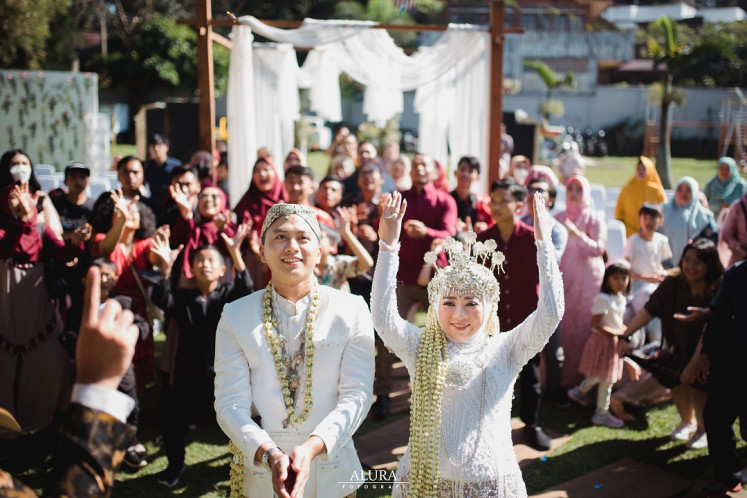Popular Reads
Top Results
Can't find what you're looking for?
View all search resultsPopular Reads
Top Results
Can't find what you're looking for?
View all search resultsBalinese offerings cast a spell of harmony
Flowers and cut leaves are spread on a round rattan tray, ready to be made into canang sari (daily offerings) by Balinese Hindus to thank Sang Hyang Widhi Wasa (God Almighty) and to create a strong relationship between humans and spirits
Change text size
Gift Premium Articles
to Anyone
 Flowers and cut leaves are spread on a round rattan tray, ready to be made into canang sari (daily offerings) by Balinese Hindus to thank Sang Hyang Widhi Wasa (God Almighty) and to create a strong relationship between humans and spirits. (thejakartapost.com/Novani Nugrahani)" border="0" height="426" width="639">Flowers and cut leaves are spread on a round rattan tray, ready to be made into canang sari (daily offerings) by Balinese Hindus to thank Sang Hyang Widhi Wasa (God Almighty) and to create a strong relationship between humans and spirits. (thejakartapost.com/Novani Nugrahani)
Flowers and cut leaves are spread on a round rattan tray, ready to be made into canang sari (daily offerings) by Balinese Hindus to thank Sang Hyang Widhi Wasa (God Almighty) and to create a strong relationship between humans and spirits. (thejakartapost.com/Novani Nugrahani)" border="0" height="426" width="639">Flowers and cut leaves are spread on a round rattan tray, ready to be made into canang sari (daily offerings) by Balinese Hindus to thank Sang Hyang Widhi Wasa (God Almighty) and to create a strong relationship between humans and spirits. (thejakartapost.com/Novani Nugrahani)I was just finishing my lunch when I saw Ibu Kadek, one of the staff members at Munduk Moding Plantation Nature Resort and Spa (MMP) in Buleleng, Bali, weaving and plaiting palm leaves near the property's swimming pool. She smiled sheepishly when I approached her.
It turned out that Ibu Kadek was in the middle of making canang sari, a daily offering made by Balinese Hindus to thank the Sang Hyang Widhi Wasa (God Almighty) in praise and prayer, which is believed to create a mutual relationship between humans and spirits. It is a familiar sight in puras (temples), shops, small shrines in local houses and even on the sidewalks and steps.
The term canang sari is said to derive from Balinese words: sari (essence) and canang (small palm-leaf basket).
Concentrating on her work, Ibu Kadek skillfully cut and weaved the palm leaves into different forms of small basket. Various kinds of flowers and cut leaves, including yellow marigold flower, red flower petals and cut leaves, spread on a round rattan tray in front of her.
Originally, canang sari's main materials, also known as peporosan, included betel leaf and nuts, gambier, lime and tobacco, in which each element represented four Hindu gods.
"Nowadays, we don't always use tobacco and betel nuts since they're considered to be too expensive. The basket can also be filled with flowers or fruit," she said.
 Ibu Kadek skillfully weaves palm leaves into a miniature tray. Balinese women who live in villages, she said, usually learn the art of making canang sari from a young age. (thejakartapost.com/Novani Nugrahani)
Ibu Kadek skillfully weaves palm leaves into a miniature tray. Balinese women who live in villages, she said, usually learn the art of making canang sari from a young age. (thejakartapost.com/Novani Nugrahani)
When I complimented her on her weaving speed and precision, Ibu Kadek told me that Balinese women who lived in villages usually learned the art of making canang sari from when they were little.
"Usually the skill is passed down from their parents and grandparents and taught at home or at the pura. Nowadays, this kind of craftmanship is also taught at schools," said Ibu Kadek.
The colors of the flowers used as offerings are said to symbolize different gods. The white flowers are a symbol of Iswara, red is Brahma, yellow is Mahadeva and the blue or green ones are Vishnu.
The mini baskets made by Ibu Kadek also come in various shapes and designs. She pointed to a cone-shaped canang sari and said: "We only use this type of offering when one of our family members die."
When I strolled around the MMP property, I found that the staff also grew flowers such as marigold and hortensia to meet the needs of offertory materials at the resort.
"We need to make canang sari every day, not only because we have to but because we believe that it'll maintain the balance and harmony of our lives," said Ibu Kadek.
span class="caption">Flowers and cut leaves are spread on a round rattan tray, ready to be made into canang sari (daily offerings) by Balinese Hindus to thank Sang Hyang Widhi Wasa (God Almighty) and to create a strong relationship between humans and spirits. (thejakartapost.com/Novani Nugrahani) I was just finishing my lunch when I saw Ibu Kadek, one of the staff members at Munduk Moding Plantation Nature Resort and Spa (MMP) in Buleleng, Bali, weaving and plaiting palm leaves near the property's swimming pool. She smiled sheepishly when I approached her. It turned out that Ibu Kadek was in the middle of making canang sari, a daily offering made by Balinese Hindus to thank the Sang Hyang Widhi Wasa (God Almighty) in praise and prayer, which is believed to create a mutual relationship between humans and spirits. It is a familiar sight in puras (temples), shops, small shrines in local houses and even on the sidewalks and steps. The term canang sari is said to derive from Balinese words: sari (essence) and canang (small palm-leaf basket). Concentrating on her work, Ibu Kadek skillfully cut and weaved the palm leaves into different forms of small basket. Various kinds of flowers and cut leaves, including yellow marigold flower, red flower petals and cut leaves, spread on a round rattan tray in front of her. Originally, canang sari's main materials, also known as peporosan, included betel leaf and nuts, gambier, lime and tobacco, in which each element represented four Hindu gods. "Nowadays, we don't always use tobacco and betel nuts since they're considered to be too expensive. The basket can also be filled with flowers or fruit," she said. Ibu Kadek skillfully weaves palm leaves into a miniature tray. Balinese women who live in villages, she said, usually learn the art of making canang sari from a young age. (thejakartapost.com/Novani Nugrahani) When I complimented her on her weaving speed and precision, Ibu Kadek told me that Balinese women who lived in villages usually learned the art of making canang sari from when they were little. "Usually the skill is passed down from their parents and grandparents and taught at home or at the pura. Nowadays, this kind of craftmanship is also taught at schools," said Ibu Kadek. The colors of the flowers used as offerings are said to symbolize different gods. The white flowers are a symbol of Iswara, red is Brahma, yellow is Mahadeva and the blue or green ones are Vishnu. The mini baskets made by Ibu Kadek also come in various shapes and designs. She pointed to a cone-shaped canang sari and said: "We only use this type of offering when one of our family members die." When I strolled around the MMP property, I found that the staff also grew flowers such as marigold and hortensia to meet the needs of offertory materials at the resort. "We need to make canang sari every day, not only because we have to but because we believe that it'll maintain the balance and harmony of our lives," said Ibu Kadek. A colorful canang sari is pictured upon completion. Peporosan, the main part of the offerings, is made of betel leaf and nut, gambier, lime and tobacco, with each element representing the four major Hindu Gods. (thejakartapost.com/Novani Nugrahani) Balinese Hindu principles are known to revolve around obtaining balance
and harmony between different elements in life and afterlife, also known
as dasar asasi. Small efforts such as making and giving
offerings are believed to have an impact on maintaining balance between
humans, nature and the spirits. For this reason also, if one day you visit Bali and stumble upon an offering tray on the sidewalks, do respect the offering by not kicking it or stepping on it. (kes)
F
Your Opinion Matters
Share your experiences, suggestions, and any issues you've encountered on The Jakarta Post. We're here to listen.
Thank You
Thank you for sharing your thoughts. We appreciate your feedback.
Share options
Quickly share this news with your network—keep everyone informed with just a single click!
Gift Premium Articles
to Anyone
Share the best of The Jakarta Post with friends, family, or colleagues. As a subscriber, you can gift 3 to 5 articles each month that anyone can read—no subscription needed!
Continue in the app
Get the best experience—faster access, exclusive features, and a seamless way to stay updated.










